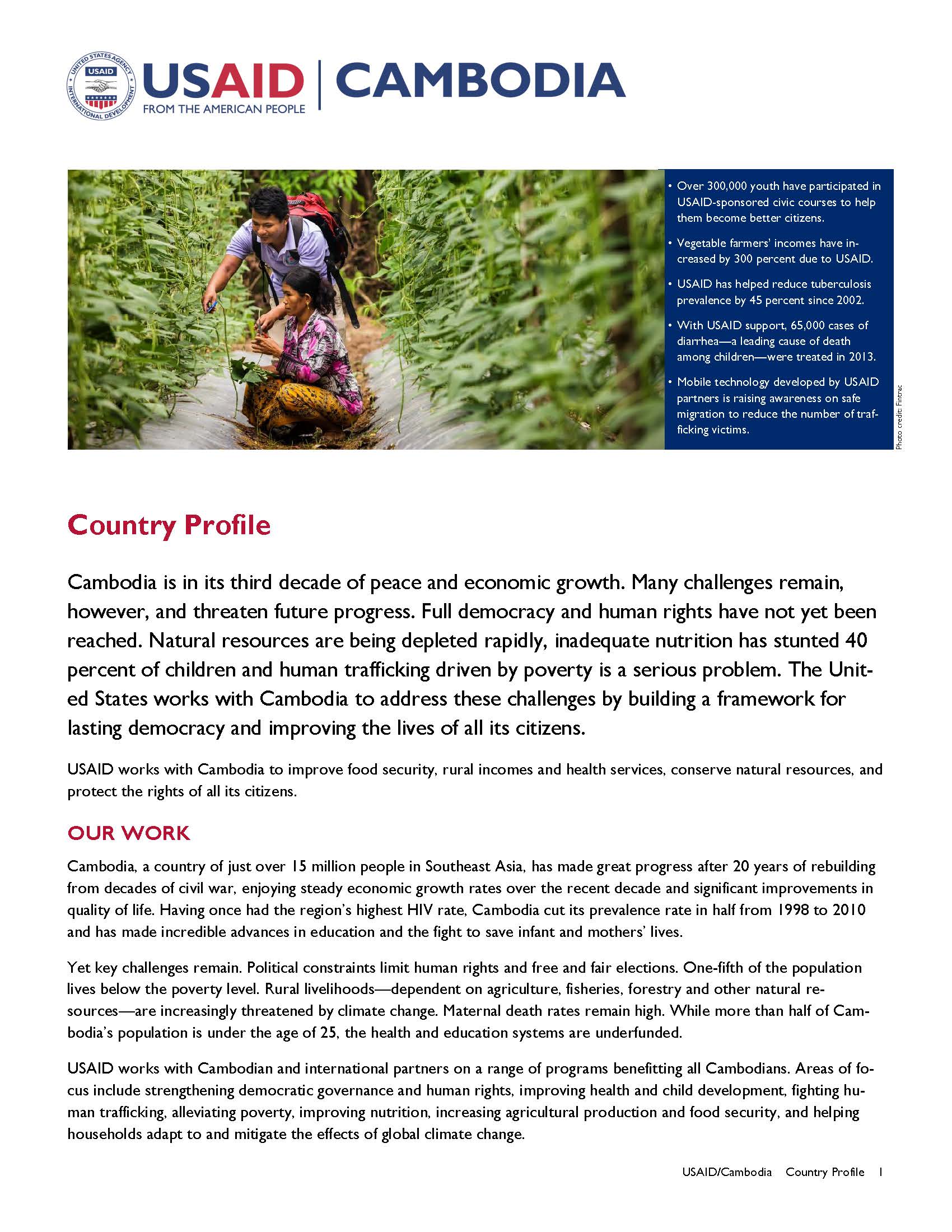![]() (321k) Cambodia Country Profile
(321k) Cambodia Country Profile
Cambodia, a country of just over 15 million people in Southeast Asia, has spent the last 20 years rebuilding from decades of civil war. The country has made great progress, enjoying steady economic growth rates over the recent decade and significant improvements in quality of life. Having once had the region’s highest HIV rate, Cambodia cut its prevalence rate in half from 1998 to 2010 and has made incredible advances in its fight against tuberculosis and infant deaths.
Key challenges, however, remain. Political constraints limit human rights and full and fair elections. One-fifth of the population lives below the poverty level. Rural livelihoods, dependent on agriculture, fisheries, forestry and other natural resources, are increasingly threatened by climate change. Maternal death rates remain high. While more than half of Cambodia’s population is under the age of 25, the health and education systems are underfunded.
USAID works with Cambodian and international partners on a broad range of programs designed to benefit all Cambodians. Areas of focus include strengthening democratic governance and human rights, improving health and child development, fostering economic growth, alleviating poverty, increasing agricultural production and food security, helping households adapt to and mitigate the effects of global climate change, and fighting trafficking in persons.
- A USAID-sponsored elections hotline provided candidate and voting information to 560,000 callers leading up to Cambodia’s 2013 elections.
- Cambodian farmers assisted by USAID increased rice yields by 30 percent.
- USAID helped Cambodia halve its HIV prevalence rate in 12 years.
- USAID-supported secondary school students have a 96 percent retention rate (national average: 80 percent).
- Mobile technology developed by USAID partners is helping garment workers learn their rights.
Democracy, Human Rights and Governance
USAID engages Cambodia’s government and civil society to strengthen key political and civil liberties, increase participation in the political process and combat human trafficking. The Agency supports civil organizations advocating for democracy and protecting the rights of vulnerable populations and also enables them to use innovative social media to educate and inform Cambodians. USAID’s assistance has resulted in an expansion of citizen expression and media attention to critical land issues and environmental crimes. USAID also helped create the National Anti-Human Trafficking Committee that leads and coordinates efforts by the Cambodian government and civil society to combat human trafficking.
Food Security and Environment
Under the U.S. Government’s Feed the Future and Global Climate Change development initiatives, USAID is helping to expand agricultural production, assist farmers in better managing their harvests, increase food access and income for the rural poor, and improve natural resource management and farmer adaptation to climate change. A key component to our work in this area is helping farmers diversify their incomes with different crops and seasonal rotations, while engaging the private sector in providing advisory services and agriculture inputs, such as fertilizers and farming tools. USAID also works to mitigate climate change by supporting forest and biodiversity conservation in the largest remaining forests in Southeast Asia.
Global Heath
Under the U.S. Government’s Global Health Initiative, USAID works to improve maternal and child health by helping Cambodia strengthen its health delivery, enhance clinical skills, and expand community outreach and health financing for the poor. Through the U.S. President’s Emergency Plan for AIDS Relief, USAID has helped cut Cambodia’s HIV prevalence in half and helps provide treatment to over 80 percent of those living with HIV/AIDS. USAID’s support has strengthened Cambodia’s fight against tuberculosis, reducing mortality from the disease by more than half since 1990. With USAID’s help, Cambodia met its United Nations Millennium Development Goal targets in 2010 for reducing child and infant deaths.
Education
USAID improves the quality of basic education through the development of better teacher training materials and curricula. To help reduce dropout rates, USAID developed 30 teaching modules in important skill areas, such as aquaculture, sanitation and gardening, which increases the value of education to parents and children. We also provide scholarships to vulnerable populations, including girls.








Comment
Make a general inquiry or suggest an improvement.